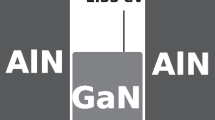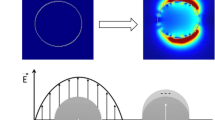Abstract
We demonstrate the optical response of metal nanoparticles and their interaction with organic-inorganic perovskite (methyl ammonia lead halide (CH3NH3PbI3)) environment using discrete dipole approximation (DDA) simulation technique. Important optical properties like absorption, scattering, and electric field calculations for metal nanoparticle using different geometry have been analyzed. The metal nanoparticles embedded in the perovskite media strongly support surface plasmon resonances (SPRs). The plasmonic interaction of metal nanoparticles with perovskite matrix is a strong function of MNP’s shape, size, and surrounding environment that can manipulate the optical properties considerably. The cylindrical shape of MNPs embedded in perovskite environment supports the SPR which is highly tunable to subwavelength range of 400–800 nm. Wide range of particle sizes has been selected for Ag, Au, and Al spherical and cylindrical nanostructures surrounded by perovskite matrix for simulation. The chosen hybrid material and anisotropy of structure together make a complex function for resonance shape and width. Among all MNPs, 70-nm spherical silver nanoparticle (NP) and cylindrical Ag NP having diameter of 50 nm and length of 70 nm (aspect ratio 1.4) generate strong electric field intensity that facilitates increased photon absorption. The plasmonic perovskite interaction plays an important role to improve the absorption of photon inside the thin film perovskite environment that may be applicable to photovoltaics and photonics.









Similar content being viewed by others
References
Green MA (2004) Recent developments in photovoltaics. Sol Energy 76:3
Willets KA, Van Duyne RP (2007) Localized surface plasmon resonance spectroscopy and sensing. Annu Rev Phys Chem 58:267–297
Barnes WL, Dereux A, Ebbesen TW (2003) Surface plasmon subwavelength optics. Nature 424:824–830
Maier S (2007) Plasmonics: fundamentals and applications. Springer, Berlin
Polman A et al (2012) Plasmonic light trapping in thin-film Si solar cells. J Opt 14:024002
Mokkapati S, Catchpole KR (2012) Nanophotonic light trapping in solar cells. J Appl Phys 112:101101
Spinelli P et al (2012) Plasmonic light trapping in thin-film Si solar cells. J Opt 14:024002
Kelly KL, Coronado E, Zhao LL, Schatz GJ (2003) The optical properties of metal nanoparticles: the influence of size, shape, and dielectric environment. Phys Chem B 107:668–677
Bohren CF (1983) How can a particle absorb more than the light incident on it. Am J Phys 51:323–327
Brongersma ML, Kik PG (1988) Surface plasmon nanophotonics, springer series in optical sciences
Ji A, Sharma R, Pathak H, Pathak NK, Sharma RP (2015) Numerical simulation of plasmonic light trapping in thin-film Si solar cells: surface coverage effect. J Phys D Appl Phys 48:275101
Pillai S, Catchpole KR, Trupke T, Green MA (2007) Surface plasmon enhanced silico solar cells. J Appl Phys 101:093105
Atwater HA, Polman A (2010) Plasmonics for improved photovoltaic devices. Nature Mat 9:205
Brolo AG (2012) Plasmonics for future biosensors. Nat Photonics 6:709–713
Gaspar D, Ferreira I (2013) Influence of the layer thickness in plasmonic gold nanoparticles produced by thermal evaporation. Sci Rep 3. doi: 10.1038/srep01469
Yin YD, Gao L, Qiu CW (2011) Electromagnetic theory of tunable SERS manipulated with spherical anisotropy in coated nanoparticles. J Phys Chem C 115:8893–8899
Pin L (2010) Speed-up electronic integrated circuits with plasmonic technology. IEEE 978–1–4244-5369
Prasad PN (2012) Introduction to nanomedicine and nanobioengineering. Wiley
Aslan K, Lakowicz JR, Geddes CD (2005) Plasmon light scattering in biology and medicine: new sensing approaches, visions and perspectives. Curr Opp chem bio 9:538–544
Aslan K, Lakowicz JR, Geddes CD (2004) Nanogold-plasmon-resonance-based glucose sensing. Anal Chim Acta 517:139–114
Roco MC, Mirkin CA, Hersam MC (2011) Nanotechnology research directions for societal needs in 2020: summary of international study. J Nanopart Res 13:897–919
Hutter E, Fendler JH (2004) Exploitation of localized surface plasmon resonance. Adv Mater 16:1685
Catchpole KR, Polman A (2008) Plasmonic solar cells. Opt Express 6:21793
Pathak H, Alok J, Richa S, Sharma RP (2015) Optical properties of metal subwavelength structures for realistic geometries in a dielectric matrix using DDA: an error analysis. Plasmonics 10:783–789
Zhang Q, Large N, Nordlander P, Wang H (2014) Porous Au nanoparticles with tunable plasmon resonances and intense field enhancements for single-particle SERS. J Phys Chem 5:370
Felidj N, Grand J, Laurent G, Aubard J, Levi G, Hohenau A, Galler N, Aussenegg FR, Krenn JR (2008) Multipolar surface plasmon peaks on gold nano-triangles. J Phys Chem 128:094702
Pathak NK, Ji A, Sharma RP (2014) Study of efficiency enhancement in layered geometry of excitonic plasmonic solar cells. Appl Phy A 115:1445–1450
Kojima A, Teshima K, Shirai Y, Miyasaka T (2009) Organometal halide perovskites as visible-light sensitizers for photovoltaic cells. J Am Chem Soc 131:6050–6051
R. F. Service (2014) Energy technology: perovskite solar cells keep on surging. Science 344:458. doi:10.1126/science.344.6183.458
Zhou H, Chen Q, Li G, Luo S, Song TB, Duan HS, Hong Z, You J, Liu Y, Yang Y (2014) Photovoltaics interface engineering of highly efficient perovskite solar cells. Science 345:542–546
Chander N, Chandrasekhar PS, Komarala VK (2014) Solid state plasmonic dye sensitized solar cells based on solution processed perovskite CsSnI3 as the hole transporter. RSC Adv 4:55658–55665
Hagfeldt A, Boschloo G, Sun L, Kloo L, Pettersson H (2010) Dye-sensitized solar cells. Chem Rev 110:6595–6663
Santiago FF, Bisquert J, Cevey L, Chen P, Wang M, Zakeeruddin SM, Gratzel M (2009) Electron transport and recombination in solid-state dye solar cell with spiro-OMeTAD as hole conductor. J Am Chem Soc 131:558
Cai N, Moon SJ, Cevey-Ha L, Moehl T, Humphry-Baker R, Wang P, Zakeeruddin SM, Gratzel M (2011) An organic D-π-a dye for record efficiency solid-state sensitized heterojunction solar cells. Nano Lett 11:1452
Green MA, Baillie AH, Snaith HJ (2014) The emergence of perovskite solar cells. Nat. Photonics 8:506
Lin Q, Ardalan A, Chandra R, Nagiri R, Burn PL, Meredith P (2015) Electro-optics of perovskite solar cells. Nat Photonics 9:106
Loper P, Stuckelberger M, Niesen B, Werner J, Filipic M, Moon S-J, Yum J-H, Topic M, De Wolf S, Ballif C (2015) High photoluminescence efficiency and optically pumped lasing in solution-processed mixed halide perovskite semiconductors. J Phys Chem Lett 6:66–71
Park NG (2013) Organometal perovskite light absorbers toward a 20 % efficiency low-cost solid state mesoscopic solar cell. J Phys Chem Lett 4:2423–2429
Snaith HJ et al (2013) Perovskites: the emergence of a new era for low-cost, high-efficiency solar cells. J Phys Chem Lett 4:3623–3630
Snaith HJ et al (2013) Enhancement of perovskite-based solar cells employing core-shell metal nanoparticles. Nano Lett 13:4505–4510
Liu F et al (2015) Plasmonic-enhanced perovskite solar cells using alloy popcorn nanoparticles. RSC Adv 5:11175
Mhaisalkar SG et al (2014) Current progress and future perspectives for organic/inorganic perovskite solar cells. Mat Today 17:1
Carlo AD (2014) High efficiency CH3NH3PbI(3_x)Clx perovskite solar cells with poly(3-hexylthiophene) hole transport layer. J Power Sources 251:152–156
Garcia MA (2011) Surface plasmons in metallic nanoparticles: fundamentals and applications. J Phys D Appl Phys 44:283001
Sangita JA, Sharma RP (2012) A study of nanoellipsoids for thin-film plasmonic solar cell applications. J Phys D Appl Phys 45:275101
Haynes CL, McFarland AD, Zhao LL, Richard P, Duyne V, Schatz GC (2003) Nanoparticle optics: the importance of radiative dipole coupling in two-dimensional nanoparticle arrays. J Phys Chem B 107:7343–7350
Hao E, Schatz GC, Hupp JT (2004) Synthesis and optical properties of anisotropic metal nanoparticles. J fluoresence B 120:357–366
Vial A, Grimault AS, Macías D, Barchiesi D, de la Chapelle ML (2005) Improved analytical fit of gold dispersion: application to the modeling of extinction spectra with a finite-difference time-domain method. Phys Rev B 71(8):085416
Ladanov M, Cheemalapati S, Pyayt A (2013) Optimization of light delivery by a nanowire-based single cell optical endoscope. Opt Express 21:28001–28009
Luo L et al (2015) Surface plasmon propelled high-performance CdSe nanoribbons Photodetector. Opt Express 23:12979–12988
Draine BT, Flatau PJ (1994) Discrete-dipole approximation for scattering calculations. J Opt Soc Am 11:1491–1499
Draine BT, Flatau PJ (2012) Fast near field calculations in the discrete dipole approximation for regular rectilinear grids. Opt Express 20:1247
Palik ED (1985) Handbook of optical constants of solids. Academic, Orlando
Knight MW, King NS, Liu L, Everitt HO, Nordlander P, Halas NJ (2014) Aluminum for plasmonics. ACS Nano 8:834–840
Wei Z et al (2013) Enhancement of perovskite-based solar cells employing core–shell metal nanoparticles. Nano Lett 13:4505–4510
Roopak S, Pathak NK, Ji A, Sharma RP (2015) Numerical simulation of broadband scattering by coated and noncoated metal nanostructures using discrete dipole approximation method. Plasmonics. doi:10.1007/s11468-015-0052-x
Draine BT and Flatau PJ. User guide to the discrete dipole approximation code DDSCAT 7.3, available at http://arxiv.org/abs/1202.3424
Draine BT, Flatau PJ (2008) The discrete dipole approximations for periodic targets: theory and tests. J Opt Soc Am 25:2693–2703
Jackson JD (1999) Classical electrodynamics, 3rd edn. Wiley, New York
Johnson PB, Christy RW (1972) Optical constants of the Noble metals. Phys Rev B 6:4370
AM1.5 spectra, American society for testing, http://rredc.nreal.gov/solar/spectra/am1.5
Shockley W, Queisser H (1961) Detailed balance limit of efficiency of p-n junction solar cells. J Appl Phys 32:510
Author information
Authors and Affiliations
Corresponding author
Rights and permissions
About this article
Cite this article
Pathak, H., Ji, A., Pathak, N.K. et al. Resonant Broadband Field Enhancement in Cylindrical Plasmonic Structure Surrounded by Perovskite Environment. Plasmonics 12, 1511–1522 (2017). https://doi.org/10.1007/s11468-016-0413-0
Received:
Accepted:
Published:
Issue Date:
DOI: https://doi.org/10.1007/s11468-016-0413-0




